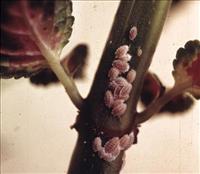|
|
|
|
|

Caption: Mealybugs on Coleus
Photo by: unknown
|
|
Mealybugs
(revision date: 5/4/2022)
Use Integrated Pest Management (IPM) for successful pest management.
Biology
Several species of mealybugs can attack houseplants. Mealybugs get their name from the white, powdery or cottony wax which covers their grayish to pinkish bodies. This cottony material is often the earliest sign of an infestation to be noticed. They are slender, flattened, soft-bodied insects which feed by sucking juices from leaves and stems. Mealybugs are usually about 3/16” long. They may be found on the undersides of leaves, in the joints where stems branch, or in protected areas and crevices anywhere on the plant, including at the base of the plant and even below the soil. Symptoms of mealybug feeding include leaf drop, stunting, or even plant death. Mealybugs may also produce honeydew, a shiny, sticky substance which may accumulate on lower leaves or surfaces below infested plants. Black sooty mold will sometimes grow on the honeydew. While the mold will not harm the plant, it is unsightly and may become a problem on household surfaces.
|
|
|
Management Options
Non-Chemical Management
- Do not move plants inside from outdoors. If you must move plants indoors, they should be quarantined (for example, in a spare bedroom) and kept isolated from other indoor plants for about a month. During this time, regularly inspect the quarantined plants for pest problems. Treat pest problems as necessary and continue isolation until the plants are “clean” for at least one full month before integrating them with the rest of your plant collection.
- Quarantine and monitor newly purchased plants or plants from your collection which have become infested with pests.
- Heavily infested plants may be too damaged to save. Get rid of them!
- Prune or pinch off heavily infested leaves and shoots.
- Mealybugs may be crushed with the fingers or wiped off plant stems and leaves. Wiping them with cotton swabs or balls moistened in rubbing alcohol may provide adequate control for light infestations. Excessive alcohol use may harm some plants. If you are concerned, test on a single leaf and wait a few days to check for damage.
- Sooty mold may be wiped or washed off leaf surfaces with lukewarm water. Clean other household surfaces with a damp cloth or appropriate cleaner.
- Do not overfertilize. Mealybugs thrive on lush new growth. Consider switching to a lower-nitrogen fertilizer or a slow-release product.
Select non-chemical management options as your first choice!
Chemical Management
Chemical controls are NOT RECOMMENDED on edible plants (i.e. herbs, salad greens, etc.) grown indoors for culinary use. When practical, take houseplants outdoors to a shaded location before applying chemical controls. Allow sprays to dry thoroughly before returning plants indoors.
Thorough coverage of the plant including the undersides of leaves, crevices between branches and the entire plant crown is essential when using a foliar spray. It may be necessary to remove soil around the crown when spraying to control mealybugs feeding below the soil surface.
If you choose to use a pesticide, some examples of products that are legal in Washington are listed below. Some products are labeled for just INDOOR or just OUTDOOR use, or may allow both uses. Be sure to choose a product appropriate for your situation. Always read and follow all label directions.
|
|
Images
+ Show larger images
| |

Caption: Mealybugs on Coleus
Photo by: unknown
|
|
|
|
|
